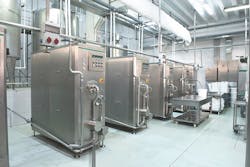Mixers are widely used to mix different materials and facilitate processes and reactions in industrial and manufacturing plants. However, little has been published for engineers about these machines. The specific design, operating arrangement and power requirements of mixers and mixing systems depend largely on the degree of mixing and the desired form of mixed product. In most cases, the mixing process is for intermediate mixing of product that will be used in the process, reaction, production and manufacturing. Therefore, quality and characteristics of mixing play a major role in the operation as well as the quality and quantity of the final product.
Mixing applications
Mixing is applied to achieve specified results in many different situations and applications, including: creating a suspension of solid particles, blending miscible liquids, dispersing gases through liquids, blending or dispersing immiscible liquids in each other, and promoting heat transfer between a fluid or different fluid and the coil or jacket of a heat exchanging device, among others.
The operating characteristics and design configuration of a mixer or mixing system are based on the power rating and required energy expenditure to create or approximate a homogeneous fluid. For example, in producing an emulsion, sufficient installed mixer power should be available, and enough energy should be applied to break up the dispersed phase. In doing so, high shear stresses, which depend on velocity gradients, are developed in the mixing medium.
In zones where the velocity gradient approaches a maximum, an intensive breaking up of the dispersed phase occurs. Mixing action reduces concentration and temperature gradients in the mixing materials, thus exerting a favorable situation for a homogeneous product. This applies particularly to dissolving applications, electrolysis, crystallization, absorption, extraction, heating or cooling and heterogeneous reactions, which proceed mostly in a liquid medium.
Increased turbulence of the fluid caused by mixing leads to a decrease in the fluid’s boundary layer thickness. This is derived from a continuous renewal of the surface contact area, resulting in a pronounced rate of increase in heat and mass transfer mechanisms.
Mechanical mixers and pneumatic mixers
Regardless of the medium that is mixed, whether liquid-liquid, gas-liquid, liquid-solid, etc., two basic methods are employed for the mixing. These are mechanical mixers, which use different types of impellers, and pneumatic mixers, which use air or an inert gas to affect mixing. In addition to these options, mixing is achieved in normal fluid handling operations, such as in pumps and jet flows. This might be considered as mechanical mixing. In fact, pneumatic mixers have been commonly specified and used.
Major characteristics of mixing
Two major characteristics of all mixing devices that provide a basis for comparative evaluations include:
- Efficiency of a mixing device
- Intensity of mixing
The efficiency of a mixer or mixing device characterizes the quality of the process to be treated. This is often expressed differently depending on the mixing purpose. For example, in producing suspensions, mixing efficiency is characterized by the uniform distribution of the solid phase in the volume of product. For the intensification of thermal and diffusion processes, it is characterized by the ratio of mixed and unmixed heat and mass transfer coefficients, respectively. Mixing efficiency depends not only on the design of mixer or mixing equipment, but also on the amount of energy introduced in the liquid or materials being agitated.
The intensity of mixing is determined by the time required to achieve a desired result or by the mixer speed for mechanical mixers. It is nearly always beneficial to achieve the required mixing effect in the shortest possible time. In evaluating the energy required for a mixing operation, total energy consumption should be considered during the time needed to achieve a specified mixing result.
Mechanical industrial mixers
Mechanical mixers or mechanical mixing devices comprise three basic parts: an impeller, a shaft and a driver system, which usually includes a speed-reducing gearbox. The impeller constitutes the working element of the apparatus, mounted on a vertical, horizontal or inclined shaft. The shaft may be connected directly to an electric motor — usually a low-speed one — or through a gearbox. While there are many impeller types for mixers, the three most widely used are: propeller, turbine and paddle mixers. The shaft can be rotating vertically, horizontally or an inclined shaft.
The propeller type is similar to an aircraft propeller. The turbine type resembles a turbine, centrifugal pump impeller or marine propeller. Depending on the height of the liquid layer, one shaft may carry one, two or three propellers.
Propeller mixers
Propeller mixers are used in different services and applications. Due to their more streamlined shape, a propeller mixer’s power requirements are less than other types of mixers at the same Reynolds number. They are capable of high-speed operation without the use of a gearbox, hence provide a more cost-effective operation because there are no mechanical losses in the gear system and transmission.
Propeller mixers produce an axial flow, which has a great pumping effect and provides short mixing times. Disadvantages compared to paddle and turbine mixers include higher initial cost, the sensitivity of operation to the geometry of the container (vessel or tank) and its location within the tank/vessel. They should not be used in square tanks or in vessels with flat or concave bottoms.
“Mixing efficiency depends not only on the design of mixer or mixing equipment, but also on the amount of energy introduced in the liquid or materials being agitated.”
A rotating propeller traces out a helix in the fluid, from which a full revolution moves the liquid longitudinally to a fixed distance. There is a flow of materials, which results from the delivery head of the propeller and the helical turbulent flow of the entire contents of the container or vessel. This is caused by the radial velocity gradients in the liquid strata at different distances from the impeller. At high rotational speeds, the entire fluid mass swirls despite the axial flow, and a central vortex begins to form around the shaft.
Draft tubes are employed to improve the mixing of large quantities of liquids by directing the motion of the liquid. In such applications, a high pumping capacity of the mixer is used, especially where mixtures of low viscosity are concerned. The draft tube directs the flow to the regions of the vessel (or tank) that otherwise would not be agitated by the liquid stream. In the absence of draft tubes and at high rotational velocities of the propeller, baffles are generally located at various points in the vessel or tank. Baffles minimize vortex formation and divide it into a number of local eddies, increasing the total turbulence of the tank or vessel.
Depending on the application, multiple impellers may be mounted on a single revolving shaft, and more than one shaft may be employed in a given tank or vessel. In some applications, it is desirable to have two adjacent impellers rotating in opposite directions, forming a beater.
Propeller mixers are used for mixing liquids in a wide range of viscosities. They are suitable for the formation of low-viscosity emulsions, for dissolving applications and for liquid-phase reactions. As a rule of thumb for suspensions, the upper limit of the particle size is 0.1 to 0.5 millimeters, with a maximum dry residue of 10 percent. While these are preferred values, some mixers have been used outside the mentioned values. Propeller mixers are unsuitable for suspending rapid settling substances and for the absorption of gases. Propellers are usually provided on the basis of data obtained from properly executed modeling experiments.
Turbine mixers
Turbine mixers represent an important class of mixers. A turbine mixer is like a centrifugal pump impeller; it has essentially a constant blade angle with respect to a vertical plane, over its entire length or over finite sections, having blades either vertical or set at an angle less than 90 degrees with the vertical. Blades may be curved or flat.
Turbine mixer operation is analogous to that of a centrifugal pump impeller working in a vessel against negligible back pressure. The mixing action is accomplished by the turbine blades, which entrain and discharge the liquid. The predominantly radial flow from the impeller impinges onto the vessel walls, where it splits into different streams. These streams cause mixing by their energy. When turbine mixers are operated at sufficiently high rotational speeds, both radial and tangential flows become pronounced, along with vortex formation. This flow situation needs the installation of baffles to ensure a more uniform flow distribution throughout the mixing vessel or tank.
Paddle mixers
Paddle mixers are devices consisting of two or more blades mounted on a vertical or inclined shaft. The main advantages of paddle mixers are their simplicity and low cost. A disadvantage is their small pumping capacity (a slow axial flow), which does not provide a thorough mixing of the volume of the tank or vessel. Perfect mixing is obtained only in a relatively thin stratum of liquid in the immediate vicinity of blades. The turbulence spreads outward slowly and imperfectly into the entire contents of the tank (or vessel); hence, circulation of the liquid is slow.
Because of a concentration gradient that often is created in the liquid when these mixers are used, they are often considered unsuitable for continuous operation. This can be remedied by tilting the paddle blades 30 to 45 degrees to the axis of the shaft, resulting in an increase in axial flow and, consequently, a decrease in concentration gradients. Such a mixer can keep particles suspended, provided settling velocities are not high. Mixers with tilted blades are used for slow reactions, which are not limited by diffusion.
To increase the turbulence of the medium in tall tanks or vessels with a large height-to-diameter ratio, a special configuration of multilevel paddle mixer has been introduced. This consists of several paddles mounted one above the other on a single shaft. The separation between individual paddles lies in the range of 0.4 to 0.9 times the diameter of the paddle and is selected according to the viscosity of the mixture. Paddle diameters are usually slightly smaller than the inside diameter of the tank in such applications, so the outer and bottom edges of the paddle move close to the walls and bottom.
Leaf-shaped (broad-blade) paddle mixers are used in some applications. They provide a predominant tangential flow of liquid, but there is also turbulence at the upper and lower edges of the blade. Leaf-type blades are usually employed for services such as mixing low-viscosity liquids, intensifying heat transfer processes, promoting reactions in a reactor vessel and for dissolving materials. For dissolving applications, leaf blades usually are perforated. During the mixer’s rotation, jets are formed at the exits from the holes, which promote the dissolution of materials.
The rotational velocity of paddle mixers is in the range of 15 to 60 rpm; however, some special types might be operated outside of this speed range. For these mixers, the pumping action is small, and there is generally no danger of vortex formation. As such, paddle mixers are most often used in vessels or tanks without baffles. However, for broad-blade paddles, which operate at speeds up to 120 rpm, baffles are incorporated into the design to minimize vortex formation.
Conclusion
Millions of mixers in many types and models are used in industrial plants and facilities. Careful consideration of the quality and characteristics of the mixer can help determine the right one for the process, ensuring the desired quality and quantity of final products.
Amin Almasi is a senior rotating machinery and equipment consultant. He is a chartered Professional Engineer of Engineers Australia and IMechE. Almasi is an active member of Engineers Australia, IMechE, ASME and SPE and has authored more than 100 papers and articles dealing with rotating equipment, condition monitoring, offshore, subsea and reliability.



